#african traditional religons
Explore tagged Tumblr posts
Text

Hoodoo WitchTips: Divination🔮✨
Here are some quick but powerful protective tips to help with divination when working with tarot, oracle, bones & more.
Divination is still a form of labor, so it’s important to ground yourself and even do a bit of light healing work afterwords. It’s so easy to do divination most people forget or don’t know about these simple spiritual hygiene tips. Good spiritual hygiene, protection and healing is important during divination because you are tapping into unknown energies.
Doing these small things routinely, can help you keep your clarity of mind and even possibly prevent psychosis or trigger other mental health issues.
While Hoodoo is a closed practice, the MAJORITY of tips/tricks are present in many cultures and are not Hoodoo specific, with the exception of the usage of Florida & Kananga Water. Non Hoodoo, Brujeria or ATR practitioners can use holy or blessed pagan water as a substitute.
#hoodoo#african traditional religons#haitianvodou#vodou#brujalife#conjure#witches of color#practical witchcraft#paganblr#tarotreadersofig#tarot community#divination#oracle readings#bone reading#santería#hoodoo community#protection spell#witchblr#witchesofinstagram#brujasdeinstagram#brujas of tumblr#pagan community#spiritual cleansing#spiritualhealing#jewitchery#witches of tumblr#black witches#spells#green witch#witch tips
116 notes
·
View notes
Text
Is a Reactionary polemic the cause of fear & hatred against non western religons? 2nd migrants & religion
The white conservative polemic is that the migrant communities refuse to integrate into majority UK culture & their religious practices are not in line with Britain’s[1]. The most visible migrant community being the Pakistani Muslim communities in the North of England. Their relative success only has ingrained resentment from the white English population[2][3]. The white English in conflict with the northern England Muslim population are mainly from those who worked in the semi-skilled manual and factory jobs[4], based in the ex-Mill Towns of the north of England.
When a migrant arrives in any country, they are not a part of, the first thing they will do is too seek out people with a similar language, ethnicity, culture & religious practice It is not out of desire of deliberate segregation, that is the outsider’s supposed mutual hostility of the host countries culture. This desire is borne out of the need for safety. Outsiders are labelled with curiosity, hostile indifference, or outright open hostility[5].
The hostility varies form intolerance, outright violence to political opportunism. Each one presents different levels of danger to 1st generation migrants and us 2nd , 3rd generation descendants. Even amongst the political white liberals, Margaret Hodge a senior MP implied that poor whites suffer, because they are second to migrant families[6][7]. That is one of the may problems we as black people are up against. Even our representatives use their white privilege and legal powers to scapegoat black and brown people of a situation, which is poverty & government neglect, that is not their fault. Her comments were post 9/11 & 4 years into a war. With hindsight the 2 wars have polarised the religion, ethnicity and politics. The racist arguments of the 1960’s & 70 that immigrants will take housing and jobs while the majority white working population will lose are directly comparable to the present day one’s that say the poor white population lose out to a prosperous ethnic minority population[8].
Unless that person is exceptionally rich or talented[9][10]( for example world class musicians) who are more socially accepted based on money and popularity[11], ordinary outsiders must contend with starting as a nobody. Socially laden epitaphs are ascribed to these outsiders, even the utilitarian “migrant” & “immigrant” would be given a negative spin with connotations[12]. The migrant communities will congregate in together in what they consider safe spaces away from massed mob violence of the increasingly majority population[13]. There is not only majority against minority violence, but also minority against minority violence, with this perceived danger, people would gravitate towards protective communities and cultural & their religious spaces.
Caribbean people found their community in the local churches they set up when they first arrived in Britain[14], and still maintain to this present day. By free choice or given no option but to live in the cities, First generation migrant Caribbean & African Black people had no other option other than to reside in the inner cities for Black Britain and the suburbs (banlieue) in France.
Politics, living space and religion are intersectional and always coincide. Living space and religion are in the communities in the North of England where British Muslims live together primarily for safety as well as solidarity. With British Muslims, their perception/belief of Islam as a system within itself has legitimised the divide in hostile spaces.
Migration to the Uk is the result of government policy and the post-colonial need for commercial labour. The religions of the migrant communities have attempted to maintain the traditional practices of their original countries. This is apparent with the Pakistani Muslim community in the North of England.
The injustices inflicted upon brown peoples is historical and is worsening at this present time. In addition, racial and religious injustices have always been set against poor whites.
[1] Sally Tomlinson (2018) Enoch Powell, empires, immigrants and education, Race Ethnicity and Education, 21:1, 1-14, DOI: 10.1080/13613324.2017.1365055
[2] The Casey Review A review into opportunity and integration Dame Louise Casey DBE CB. https://assets.publishing.service.gov.uk/government/uploads/system/uploads/attachment_data/file/575973/The_Casey_Review_Report.pdf
[3] Community cohesion: the views of white working-class communities Professor Harris Beider https://www.jrf.org.uk/sites/default/files/jrf/migrated/files/working-class-community-cohesion-full.pdf
[4] https://www.runnymedetrust.org/uploads/publications/pdfs/WhoCaresAboutTheWhiteWorkingClass-2009.pdf Runnymede Trust.
[5] https://www.youtube.com/watch?v=wXnSujE3NC4 Minorities in Britain - The Pakistani Community (1966). Film extracts from a programme examining the Pakistani community in Britain, taken from a 1966 BBC2 series on Minorities in Britain. Narrated by Zaynab Dahya and produced by Michael Bunce. First broadcast on BBC2 at 7.30pm on Monday 27th June 1966.
[6] Kjartan Páll Sveinsson:7 Runnymede Trust. The Poor whites and Multiculturalism: Is There Space for a Progressive Agenda? Who Cares about the White Working Class? :7
[7] Ibid: “…“should look at policies where the legitimate
sense of entitlement felt by the indigenous family
overrides the legitimate need demonstrated by
the new migrants”
[8] ibid
[9] http://www.tracesproject.org/ An untold history of contributions to arts and culture from men and women who have sought safety in the UK from conflict and persecution.
[10] http://www.tracesproject.org/hong-dam/ Hong’s artistic expression is rooted in her experience as an eight-year-old girl
[11] https://www.buzzfeednews.com/article/shyamanthaasokan/meet-the-uk-artists-who-came-here-as-migrants-and-refugees Shyamantha Asokan.(08/05/15). Buzzfeed News. Meet the U.K. Artists Who Came Here as Immigrants.
[12] Camila Ruz. BBC News Magazine. (28/08/2015) https://www.bbc.co.uk/news/magazine-34061097
[13] Warwick University. Modern Records Centre. (11/03/20). Notting Hill Riots 1959. https://warwick.ac.uk/services/library/mrc/studying/docs/racism/riots
[14] https://unherd.com/2018/05/windrush-generation-kept-faith/ KATIE HARRISON. How the Windrush generation kept their faith
0 notes
Text
The Vodou Files
Diddy & his entitlement an blatant disrespect of Lwa Ezili Dantor/Black Madonna
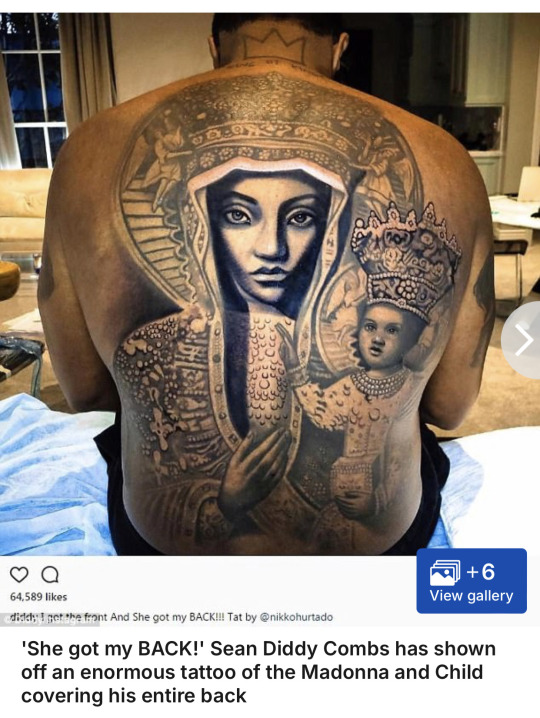
For all intent and purposes, the following information is alleged and for entertainment only.
In year of 2024, it’s no secret that Sean ‘Diddy’ Combs is a polarizing figure. After his recent arrest and federal indictment this September on charges of s*x trafficking and more, and with multiple lawsuits alleging a multitude of abuses against men and women, this cannot be denied.
Let’s get into the possible spiritual implications of his recent arrest. In 2017 Diddy tattooed the Black Madonna aka Ezili Dantor on his back, for protection. The Black Madonna syncretism is often been used in Vodou to represent the Lwa Dantor.
Here’s a rending of the photo of Ezili that he seems to have taken inspiration from for his tattoo.

Ezili Dantor is the patroness and holy mother of Haiti. She is known as a protector of women and children, and was one of the petro or war spirits who were instrumental in the Haitian Revolution of 1804, allowing the Haitians to lead the first successful slave uprising. She assisted with giving them the strength in battle to defeat their colonizers and inspired others to resistance in the Diaspora. France went bankrupt during the Haitian revolution and had to sell off their land to pay off the massive debt this caused, spurring the Louisiana purchase and leading to creation of America as we know it, today. These acres of land make up the states of Louisiana, Arkansas, Oklahoma, Kansas, Missouri, Iowa, Nebraska, Colorado, North & South Dakota, Minnesota, Wyoming and Montana. There would be no American Independence, if it hadn’t been for the Haiti.
While Ezili does not own my head, I know her children. They are usually women who are family matriarchs and mothers, who are incredibly kind, patient and strong and actively involved in their communities. They tend to be well respected within their communities and usually involved in community activism to varying degrees. They generally have a pleasant disposition but can be dangerous fighters when challenged spiritually and physically. They make great leaders and can be very wise. It is common for children of certain Lwa to take on similar traits of said Lwa & I believe this aspect can especially be seen in her children, who she claims. While I do not have her in my court, I do carry her sister aspect the darker, merciless and vengeful Le Rouge.
The Ezili are a powerful class of spirits within the Vodou pantheon. Ezili Dantor is an example of a very powerful spirit who can shift fate and reality. She is the peaceful mother but can exhibit extremely controlled violence when necessary, a triumphant warrior queen personified. She does not take disrespect or injustice lightly.
Diddy invoking her essence and protection, with this tattoo while assaulting and harming people continuously would draw her ire, wrath and ultimate disrespect. Some think someone recommended he do this to hasten his downfall or he did this out of pure stupidity.
Others of the Catholic faith, see it as the Holy Mother, the Blessed Black Madonna looking out for her children and protecting them.
Either way it’s clear the drums of justice have begun to beat for Diddy and it’s time for him to account for what he has done.
#hoodoo#the love witch#aphrodite#black femininity#Ezili Dantor#erzulie dantor#haitianvodou#haiticheri#the black madonna#the holy mother#witches of color#witchblr#african traditional religons#Haiti#lwa#vodou#voodoo#practical witchcraft#astrology#witchy things#paganblr#occult#black spirituality#spirituality#diddy#p diddy#santería#warrior queen#goddess#blessed virgin mary
25 notes
·
View notes
Text

Posted: 2/11/25
The Enchanting History of Love Magic Across Cultures
February has arrived with its whisper of roses, chocolates, and declarations of affection, the air is charged with the promises of love. Valentine's Day (Feb. 14th), though modern in its commercial veneer, is steeped in traditions that reach deep into human history. Among these, the practice of love magic—rituals, spells, and charms to attract, secure, or mend love—has traversed cultures, continents, and centuries. Let us embark on a journey to uncover how African, the African diaspora, Indigenous American, Asian, and European traditions have woven love magic into the tapestry of their spiritual and cultural practices.
Africa: Love and Spiritual Power Intertwined
In many African cultures, love magic reflects the profound connection between the spiritual and the mundane. Among the Yoruba people of Nigeria, practitioners of Ifá divination often called upon the Orisha Osun (Oshun) for love, beauty, and fertility. Offerings of honey, cowrie shells, and fresh water were made to Osun to invoke her blessings for harmonious relationships or to rekindle fading passion.
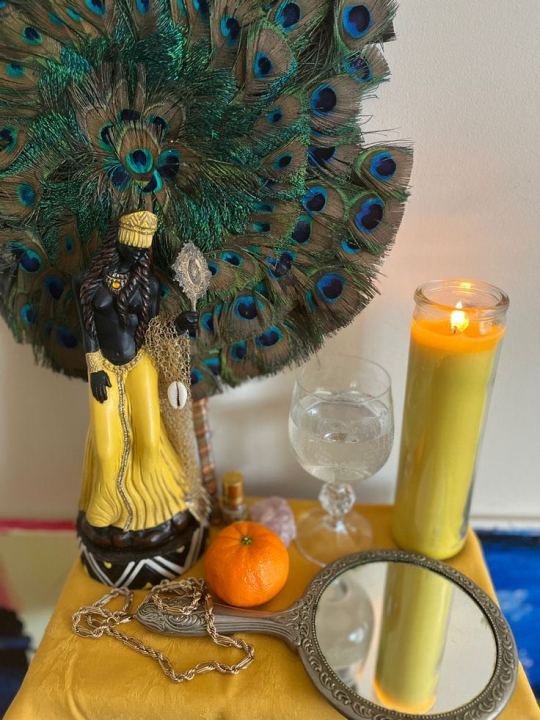
Meanwhile, across the continent, the use of botanicals for love magic was also widespread. In South Africa, for example, Sangomas (traditional healers) used herbs like "Umavumbuka" to foster reconciliation, harmony and emotional healing. These rituals often reflected the belief that love and harmony within relationships were essential for community balance, weaving personal desire into collective well-being.
African Diaspora: Love Magic in Survival and Resistance
As the African diaspora spread through the transatlantic middle passage, love magic was adapted and evolved within the crucible of multiple new environments. In the Americas, Hoodoo—an African American spiritual tradition—emerged, integrating African, Indigenous, Jewish and European influences. Practitioners used "mojo bags" filled with herbs, roots like John the Conqueror or Queen Elizabeth root and other personal items, powders or oils to draw love or fidelity. Honey jars, a sweetening spell to encourage affection and harmony, remain popular in contemporary Hoodoo practices.

In the Caribbean, Vodou and Obeah intertwined African cosmologies with local and European influences. In Haitian Vodou, for instance, Erzulie Freda, the lwa (spirit) of love and beauty, was and is still often petitioned for matters of the heart. Her rituals often included perfumes, pink and white candles, and luxurious offerings symbolizing sensual pleasure and emotional depth.
Global Indigenous Cultures: Love Magic in Harmony with Nature
For many Indigenous American cultures, love magic was less about control and more about alignment with natural energies. Among the Navajo, for instance, "beautyway" ceremonies invoked harmony and balance, which also extended to relationships. Love charms crafted from turquoise, or shells were believed to attract a compatible partner, resonating with the spiritual properties of these materials.
The Cherokee practiced rituals to strengthen bonds between lovers or to resolve conflicts. Songs, dances, and natural elements—such as cedar or sage—were integral to these ceremonies, symbolizing purification and renewal.
Indigenous peoples outside the Americas also have their own rich traditions of love magic. Among the Sami people of Scandinavia, noaidi (shamans) practiced rituals that included the use of drums and joik (a traditional form of song) to invoke spiritual assistance in matters of love and relationships. These practices were deeply tied to the natural cycles and spirits of the Nordic landscape.

In South America, the Quechua and Aymara peoples of the Andes incorporated love magic into their spiritual practices. Coca leaves, a sacred plant, were often used in divination to seek guidance about romantic relationships or to attract a desired partner. Rituals performed at sacred sites, such as mountains or lakes, were believed to align the participants with Pachamama (Mother Earth) to ensure harmony in love.
Indigenous Australian cultures often intertwined love magic with Dreamtime stories, the spiritual and temporal framework of their worldview. Rituals might have included sand drawings, chants, and symbolic offerings to attract or strengthen love, aligning the participants with the ancestral energies of the land.
Asia: The Alchemy of Love
Asian cultures have also long embraced love magic, often blending it with spiritual and philosophical traditions. In China, Taoist love spells focused on harmonizing yin and yang energies within partnerships. Charms inscribed with auspicious characters or infused with essential oils were used to attract romantic opportunities or sustain marital bliss.
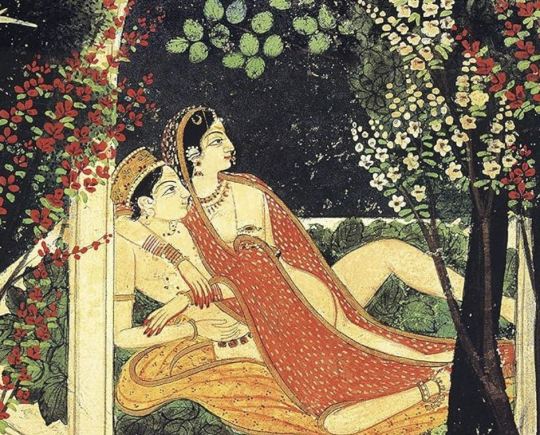
In India, the Kama Sutra, more than a manual of intimacy, delved into rituals and practices for fostering love and attraction. Ayurveda, India’s ancient medicinal system, recommended aphrodisiac herbs like ashwagandha and shatavari to enhance passion and deepen emotional connection.
Japanese folklore, on the other hand, speaks of "omamori" love talismans blessed at Shinto shrines. These were carried to invoke the protection and favor of kami (deities) for romantic endeavors.
Europe: Spells of Romance and Obsession
Europe’s history of love magic is a blend of folklore, mysticism, and religious undertones. In ancient Greece and Rome, love potions—often made from herbs like myrtle or rose—were crafted to awaken desire. Aphrodite (or Venus), the goddess of love, was frequently invoked in rituals, with offerings of doves or apples symbolizing beauty and fertility.

During the medieval and Renaissance periods, love magic often walked a fine line between fascination and persecution. The use of "philters" (love potions) and "poppets" (dolls) to influence romantic outcomes could lead to accusations of witchcraft. Yet, folk practices persisted. For instance, English cunning folk recommended carrying rose quartz to attract love, while French peasants relied on charms sewn into clothing to inspire fidelity.
Love Magic Today: A Universal Language
Despite its varied expressions, love magic is a universal thread linking humanity’s longing for connection. In modern times, these ancient traditions continue to inspire spiritual practices. From lighting candles on Valentine’s Day to crafting intention spells, the essence of love magic endures—reminding us that love is as much a spiritual endeavor as it is an emotional one.
This Valentine’s Day, whether you light a candle, gift a rose, or simply reflect on the magic of love, remember: across every culture and era, love has been a force worth invoking, celebrating, and cherishing.

Bibliography : Yoruba Religion and African Spiritual Practices: Drewal, H. J. (2009). Yoruba: Nine Centuries of African Art and Thought. Hoodoo and Vodou Traditions: Anderson, J. L. (2008). Conjure in African American Society. Indigenous American Rituals: Johnston, B. (1976). Ojibway Ceremonies. Asian Love Magic: Needham, J. (1956). Science and Civilisation in China. European Folk Practices: Kieckhefer, R. (1997). Magic in the Middle Ages. Indigenous Traditions in Australia and Scandinavia: Pentikäinen, J. (1996). Shamanism and Culture. Andean Spiritual Practices: Bastien, J. W. (1985). Mountain of the Condor: Metaphor and Ritual in an Andean Ayllu.
#history of love magic#love magic#the love witch#aphrodite#hellenic polytheism#hellenic deities#hellenic worship#karma sutra#the lovers#valentines day#Oshun#african traditional religons#hoodoo#haitianvodou#erzulie freda#love spells#february 2025#witchblr#pagan community#venus#brujeria#witches of color#magic#history#indigenous#south america#folk magic#america#european#asia
25 notes
·
View notes
Text

February 2025
Venusian Dolls & Dudes save this update of our Content Schedule for next month.
We have so much content that is marinating, on patreon, tumblr, lemon8 and more and so we've made it easier to keep track of all of it!
NEW PRODUCTS LAUNCHING !!!
Two New Love Spell Ritual Oils
Group Glamour Ritual on the 9th
Scheduled Patreon, Tumblr & Lemon 8 Content
New Herbarium Posts
History of Love Magic
Luxury Spell Drop for Empress & Star Tiers
Celebrity Glamour Profile
Oracle & Tarot Spread
Venusian Art's Course: Toolkit, Lust, Love & Beauty - Weekly Drops
Social Media Platforms
Tumblr: Lionheart Apothecary & Botanica
Facebook Page: (10) Facebook
Facebook Group: (10) Hoodoo: Love, Beauty & Glamour Magic | Facebook
Lemon8: @HoodooBarbie
Website: (Shop will be back up before January 20th) lionheartapothecary.com
Instagram: Lionheart Apothecary (@lionheartapothecaryx) • Instagram photos and videos
Substack: Lyonessa Hart | Substack
YouTube: Welcome To Lionheart Tarot
#hoodoo#the love witch#february 2025#february#lunar new year#witchesofcolor#witches of tumblr#witchblr#witchtok#paganblr#aphrodite#love magic#love spell#beauty spells#glamour spells#glamour witch#glamour magic#love witch#witchcraft#witch community#brujeria#folk magick#african traditional religons#haitianvodou#venus#siren magic#valentines day#valentine#love#black femininity
12 notes
·
View notes
Text

In light of a tragedy involving Mystic Lipstick aka Akoya, here are few quick witch tips that are invaluable for practitioners of any skill level.




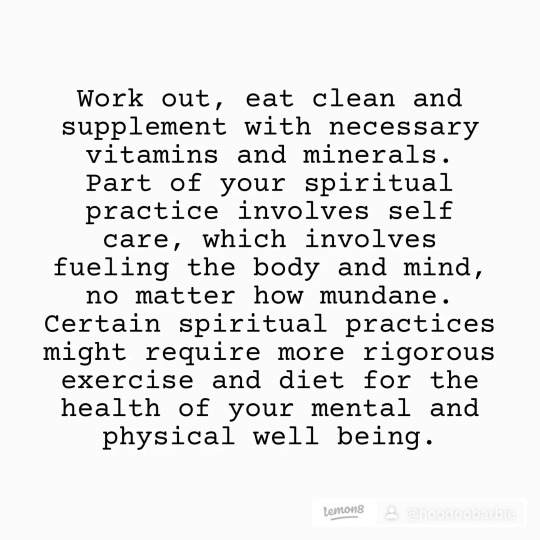
#hoodoo#the love witch#black femininity#black spirituality#bipoc mental health#mental health#practical witchcraft#witch blog#witches of color#haitianvodou#aphrodite#paganblr#occult#astrologersofinstagram#daily astrology#astrology#witchcraft#witchcraft community#jewitchery#brujas of tumblr#brujería#conjure#rootwork#folk magick#african traditional religons#african american folk magick#mental heath support#new age#Wicca#tarot community
52 notes
·
View notes
Text

The History of Candle Magic in Hoodoo, American Folk Magic & Across the Globe.
Hey there, Venusian Dudes and Dolls! 🌟
Lately I've been obsessing over candle magic and how it's so important to a multitude of cultural practices. In modern magic many practitioners use candle rituals to hone our intent and hopefully manifest the energies we desire. Maybe it's the ADHD hyperfocus but this has always fascinated me. So today I'm taking you on a journey through the bright history of candle magic—a practice steeped in mysticism, transformation, and a universal yearning to connect with the divine.
Our story begins in the ancient world, where the first candles were more like rushlights—bundles of reeds soaked in animal fat, used in ancient Africa in Egypt around 3000 BCE. These early lights weren’t just practical; they carried symbolic weight, often illuminating temples and rituals that called on divine favor. The use of reed bundles soaked in animal fat began as a practical solution to meet the need for light after sunset. Reeds, abundant along the Nile River, were a natural and accessible resource, and animal fat was a byproduct of cooking or butchery. While reeds and animal fat were early components of lighting practices in ancient Egypt, they were not the sole origin of oil lamps.

The evolution of oil lamps was influenced by a combination of available materials, cultural ingenuity, and practical needs, leading to more sophisticated designs over time.
As Egypt was a hub of trade and culture, particularly during the height of the Pharaonic and later Ptolemaic eras, these lighting methods spread along trade routes. Merchants, travelers, and nomadic communities carried this technology to other parts of North and Sub-Saharan Africa and to other lands outside of Africa.
These Egyptian oil lamps, crafted from pottery, stone, or metal, featured a reservoir for oil—commonly castor oil, sesame oil, or animal fat—and a spout to hold a plant-fiber or papyrus wick. Oil lamps were integral to daily life, lighting homes, workplaces, and public spaces. Beyond their practical use, they held significant ritual importance, often used in temples and religious ceremonies to honor deities and ensure divine favor. The soft glow of these lamps was also believed to guide souls in the afterlife, with many placed in tombs as part of funerary rites. This duality of function—practical and spiritual—reflected the Egyptian emphasis on the interconnection between earthly existence and the divine.
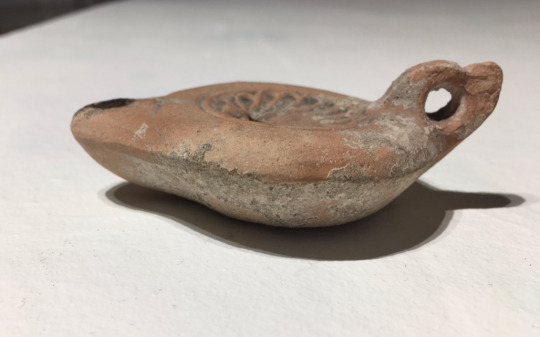

In ancient Rome, oil lamps evolved further, becoming more ornate and widely used. Romans preferred terracotta and bronze lamps, often featuring intricate designs or depictions of gods and myths. Olive oil was the most common fuel, symbolizing prosperity and abundance. Roman oil lamps illuminated homes, streets, and public baths, while their use in temples and during festivals underscored their religious significance. They also served as symbols of status, with wealthier individuals commissioning elaborate designs.

The Romans later perfected the art of candle-making with wax, creating the first dipped candles and creating objects of both daily use and sacred purpose. To these ancient peoples, the flame wasn’t merely light; it was life, a tiny sun held in the palm, connecting the earthly with the celestial.
As time flowed into the medieval era, candles found a deep and meaningful home in religious ceremonies. Catholicism and Christianity, in particular, adopted candles as symbols of divine light and spiritual purity. Every flicker in a darkened cathedrals and church became a prayer in itself, illuminating the path to salvation. The association of candles with prayer and intention became so ingrained that they naturally merged with the folk magic practiced in villages across Europe.


Here, we see some of the beginnings of candle magic as a personal, intimate practice. Villagers would light candles while uttering blessings, casting protections, or even weaving spells of love, fertility, or prosperity. The Renaissance added yet another layer to candle magic. The rebirth of Hermeticism and ceremonial magic brought a new understanding of how candles could be used to align with cosmic forces. Practitioners believed that the color of the wax, the timing of the flame, and the intention behind the lighting could channel planetary energies, summon spirits, or manifest desires. It’s no wonder that candles became indispensable in the practices of witches, alchemists, and mystics, serving as tools to focus will and amplify power.
Across the globe, candles begin to carry similar meanings. In Hindu traditions, oil lamps and candles were offered to deities as a gesture of devotion and to invoke blessings. In Afro-Caribbean practices, candles became central in rituals honoring ancestors and spirits, their light seen as a beacon guiding energies from the unseen world into the physical realm.
The History of Candle Magic in the Americas
The history of oil lamps and candles in America ties into the colonial and early settler experience. In the early 1600s, colonists brought tallow candles, made from animal fat, as their primary light source. These candles were smoky, smelly, and burned quickly, but they were accessible to all. By the 1700s, whale oil lamps became popular among wealthier settlers, producing a cleaner and brighter flame. However, enslaved and impoverished communities often relied on homemade tallow candles or simple oil lamps, repurposing whatever materials were available. The multicultural blending that defined American folk magic brought spiritual significance to these utilitarian objects.
In Hoodoo, a system of African American folk magic which is deeply multi-cultural and rooted in African, Indigenous, Judaistic and other practices, oil lamps and candles became potent tools for connecting with ancestors, spirits, and divine forces. Oil lamps were the original form of candle magic before the advent of electricity, and were longer lasting the candles. Hoodoo practitioners, often called rootworkers or conjure doctors, would craft oil lamps as magical devices by combining oils, herbs, minerals, and even personal items of the target (like hair or nails) inside the lamp. When lit, the flame was believed to activate the spell, drawing in spiritual assistance or amplifying the worker’s intention. These lamps were often made from everyday materials like mason jars or old lanterns, emphasizing the resourcefulness and ingenuity of Hoodoo practitioners in the face of oppression and scarcity.
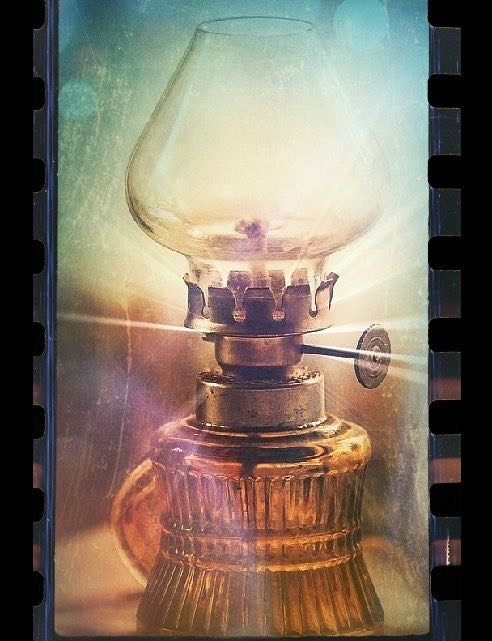
As time progressed, Hoodoo folk magic evolved with the times. Candles were introduced and now play a central role in Hoodoo. Each candle color carried a specific symbolic meaning: green for money, red for love, black for protection or banishing negativity, and white for purity and spiritual clarity. Practitioners would carve their intentions directly onto the candle or dress it with oils and herbs before lighting it. As the candle burned, its flame became a channel for prayer, intention, or communication with the spiritual world.
In Appalachian Granny magic, another eclectic and practical form of folk magic rooted in the mountains, candles and oil lamps were tools of necessity that took on a mystical role. The grannies, as these wise women were lovingly called, used candles and lamps in rituals of protection, healing, and divination. For example, a Granny might place a candle in a window to ward off spirits or guide a loved one safely home. They also believed in the "reading" of a candle’s flame or wax drippings, interpreting flickers, cracks, and shapes as signs or messages from the spiritual realm. Oil lamps were similarly revered in Appalachian folk magic. Often kept burning in the home, they symbolized the hearth and protection of the family. These lamps were sometimes used in protective magic, with certain oils or charms placed inside to keep malevolent forces away. If illness struck a household, the lamp’s light might be used as a focus for healing prayers or blessings.
The multicultural blending that defined American folk magic brought spiritual significance to these utilitarian objects. African enslaved people integrated their knowledge of oils, herbs, and spiritual practices into their use of lamps and candles. Meanwhile, European settlers added their traditions of candle-burning spells and charms. In Appalachia, the influence of Celtic, Germanic, and Native American traditions created a unique fusion of spiritual and practical uses for light.
By the 19th century, paraffin candles became widely available, offering a longer burn time and cleaner light. These advancements allowed magical practices to become more elaborate, with practitioners using candle wax readings or crafting intricate oil lamp spells.
Metaphysical Reason why Lamps & Candles Work in Ritual
The power of oil lamps and candles lies in their unique ability to combine all the elements. Both oil lamps and candles are transformational tools, combining the elements of fire (flame), earth (wax or oil), air (smoke), and spirit (intention). The flame is fire; the melting wax, oil, glass or clay base is earth; and the smoke it produces, air. This elemental balance makes candles perfect for spell work, because it seeks harmony between the practitioner and the universe. When a lamp or candle burns, it transforms solid oil or wax into smoke and heat, symbolizing the alchemical process of turning intention into reality. No wonder they’re seen as conduits for wishes, blessings, and change. Their light is seen as a direct link to the divine, symbolizing clarity, hope, and the power to transform one’s reality. Whether guiding spirits, warding off evil, or sending a prayer to the heavens, these lights illuminate more than the physical world— oil lamps and candle can light the path to magic itself.

So, the next time you light a candle for a spell, a wish, or even just to create a cozy vibe, remember that you’re tapping into a practice as old as time itself. From ancient Egyptian temples to your modern altar, candles have always been there, carrying our hopes and dreams skyward, one flicker at a time. Whether you’re burning a dressed candle in a conjure spell or lighting an oil lamp to protect your home, know that you are a part of a global lineage of witches, priests, magicians, grannies, and root workers who have used the power of flame to ignite change, protect the vulnerable, and honor the divine.
xoxo
Lyonessa
#hoodoo#paganism#ancient egypt#ancient rome#ancient greece#candle magic#pagan community#witches of color#baby witch tips#baby witch#history#witch content#witch community#haitianvodou#black femininity#conjure#rootwork#folk magic#african traditional religons#oil lamp#witchblr#beauty spells#spellcasting#spellcraft#witchcraft#spells#beginner witch#wicca#hoodoo heritage month#hoodoo community
10 notes
·
View notes
Text
Spooky Lesser Known Spirits 🔮🕯️
TikTok Series for Hoodoo Heritage 2024
#hoodoo#pagan community#witchesofcolor#witchesoftiktok#tiktok#spirits#demons#ghosts#spiritual warfare#spirituality#hoodoo community#hoodoo heritage month#halloween#october#hoodoo aesthetic#witch blog#witchblr#black witches#conjure#spiritualcleanse#practical witchcraft#witch community#brujalife#brujeria#african traditional religons#black american culture#canva#spiritualhealing#divination#wicca
13 notes
·
View notes
Text
HAPPY HAITIENNE HERITAGE MONTH ! 🇭🇹
BLACK CULTURE & GLAMOUR
#hoodoo#black femininity#papa damballah#rainbow dragon#the love witch#haiticheri#launionforce#la unión suite#black womanhood#black witches#vodou#african traditional religons#lwa#conjure#brujeria#brujamoderna#witchesofcolor#kreyol
42 notes
·
View notes